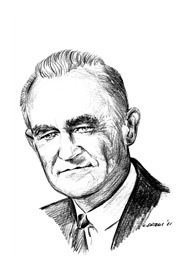Robert M. Stanley (August 19, 1912 – July 16, 1977) was an American test pilot and engineer. He became the first American to fly a jet aircraft on October 2, 1942, as a civilian test pilot for Bell Aircraft. He flew the Bell XP-59A Airacomet, which was the United States’ first turbojet aircraft. The flight took place at Muroc Dry Lake, California. The Airacomet is on display at the National Air and Space Museum in Washington, D.C. Family history: Robert Stanley was born in 1912, to George W. Stanley and Jennie Coffman, and was the youngest of three sons. He married Katherine Norman in 1942 and had one daughter, Karin Jane, and two sons, Robert Morris Jr. and Stephen Eric.
Started the Stanley Aviation company in Buffalo, New York in 1948.Participated in the design of the DC-3 while working with Douglas Aircraft.Created a patent for a mechanically controlled reversible pitch propeller later copied and used by the German Luftwaffe.While an ensign in the United States Navy assigned to the carrier Lexington, he designed the Stanley Nomad, a high performance sailplane with an aluminum fuselage and a tapered wing. He also designed and fitted this aircraft with the first known “Vee” tail and flew it to an altitude record of 17,284 feet inside a large cumulus cloud during a soaring contest in Elmira, New York, in 1939. This glider also set a cross-country record by flying from Elmira, to the Congressional Country Club in Bethesda, Maryland. The Nomad is now in the collection of the National Air and Space Museum and displayed at the Udvar-Hazy Center near Dulles Airport in Chantilly, Virginia.Proposed the development of the Project Kingfisher guided missile.Was engineering vice president at Bell Aircraft during the design of the world’s first supersonic aircraft, the Bell X-1.He moved Stanley Aviation to Aurora, Colorado, adjacent to Denver’s Stapleton Airport, where he patented and built ejection seats for jet fighter and bomber aircraft. He developed “escape pod”-style ejection seats for safe ejection from disabled aircraft flying at supersonic speeds. These were used in the Convair B-58 ‘Hustler’ bomber and the North American RS-70 prototype supersonic bombers, among other designs. Stanley Aviation building have been re-purposed and today house many businesses and is known as the Stanley Marketplace.First developed the idea of launching an aircraft from another aircraft at high altitude, which was used for the launch of the Bell X-1 and X-2 experimental research aircraft from the bomb bay of a Boeing B-50 bomber.Enjoyed white water rafting on the Colorado and Green Rivers in Colorado with his family and traversed the Grand Canyon by raft.Bob was tragically lost July 16, 1977, flying with two of his sons, along with the wife of one son and fiance of the other, and lifelong friend, Darwin Phillip Lowry of Overland Park, Kansas, in the crash of the Stanley company’s Aero Commander. The plane encountered a severe wind shear on approach to Fort Lauderdale International Airport and broke up in flight as the family was returning from a vacation trip to the Caribbean. 
